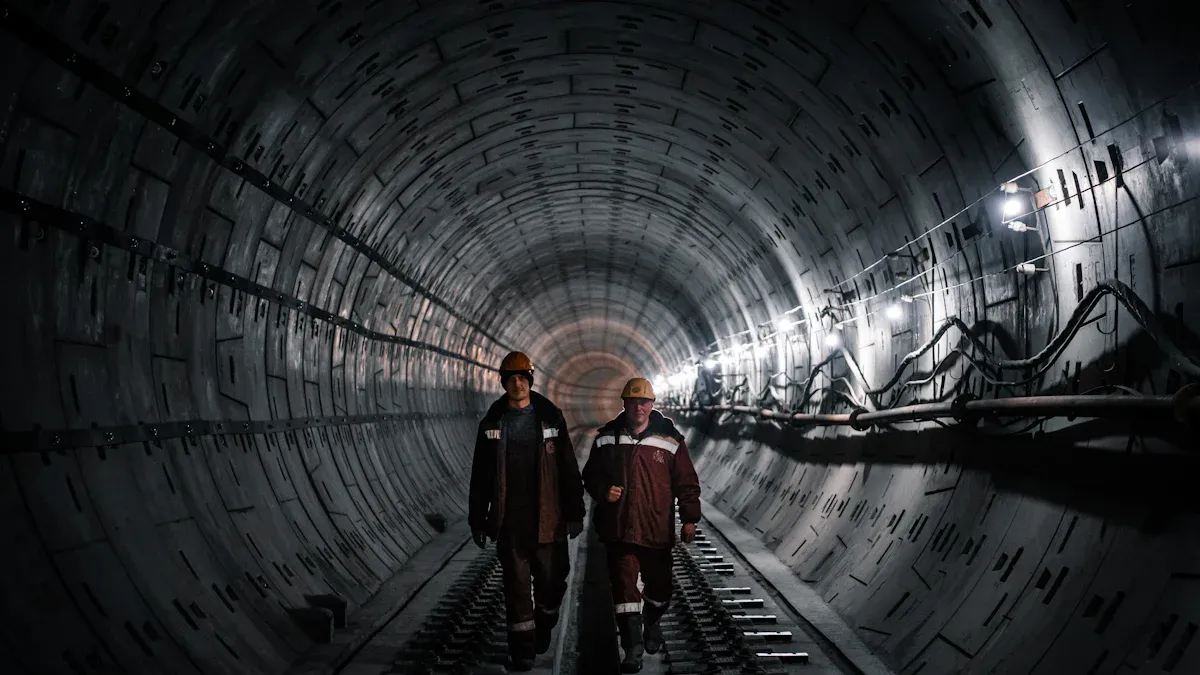
Public Tunnel telephone systems offer a vital link to help during emergencies. When mobile service fails, a waterproof Tunnel telephone continues to function. Drivers or pedestrians can use an emergency Tunnel Telephone for quick, clear communication with rescue teams. This direct line can save lives when every second matters.
Why Public Tunnel Telephone Systems Are Essential for Tunnel Safety

Unique Risks in Tunnel Environments
Tunnels present many dangers that do not exist in open spaces. People inside tunnels face risks such as fires, explosions, floods, and falling objects. Heavy machinery can cause crush injuries or accidents. Workers and users may slip and fall or get hurt by electrical lines. Sometimes, tunnel walls or ceilings collapse, trapping people inside. Harmful gases like methane and carbon monoxide can build up, making it hard to breathe.
Safety experts stress the importance of early planning and strong safety systems in tunnels. Each tunnel has its own design and hazards, so emergency plans must fit the specific site. Public Tunnel telephone systems help address these unique risks by providing a direct way to call for help when other options fail.
Overcoming Communication Barriers Underground
Communication in tunnels is difficult. Thick concrete and long distances block cell phone signals. Emergency responders cannot always see what is happening inside the tunnel. They must rely on radios or telephones, which may not work well without special equipment. Different rescue teams often use different systems and words, making it hard to share information quickly.
A Public Tunnel telephone system solves many of these problems. Phones placed at regular intervals give everyone a way to reach help fast. These phones connect directly to emergency services, even if mobile networks are down. This setup ensures that people can report their exact location and get help right away. Reliable communication tools like these save lives during tunnel emergencies.
How Public Tunnel Telephones Enhance Emergency Response

Key Safety Features and Robust Design
Engineers design public tunnel telephones to withstand the harshest tunnel conditions. These phones must operate reliably during emergencies, even when exposed to dust, water, fire, or vandalism. Manufacturers use corrosion-resistant cast aluminum, stainless steel cords, and cold-rolled steel to build the enclosures. Many models meet strict protection standards such as IP66 or IP68, which means they resist water and dust. Explosion-proof certifications like ATEX ensure the phones remain safe during fires or gas leaks.
Many public tunnel telephones feature brightly colored or illuminated designs. This makes them easy to spot in low visibility or smoky conditions.
Some key safety features include:
- Weatherproof and vandal-resistant housing
- Loudspeakers and clear audio for noisy environments
- Hardwired power with backup electricity
- Armored cords and rugged metal enclosures
- Video call capabilities for visual assessment
- Automated alerts that can trigger lockdowns or evacuations
The table below highlights the main safety features and their categories:
| Safety Feature Category | Specific Features and Description |
|---|---|
| Physical Design | High-strength synthetic materials; IP66 rating; corrosion resistant; dust and water resistant front panel design |
| Environmental Adaptability | Stable operation in high dust, noise, humidity, temperature extremes, and acidic/alkaline environments |
| Electrical Protection | Lightning protection; high-voltage surge protection on terminal and host interfaces |
| Fault Tolerance | Fault pass-through design preventing single terminal faults from affecting others |
| Power Supply | Centralized power supply; backup power ensures operation during outages |
| Communication Quality | All-digital serial mode; full-duplex calls with DSP echo cancellation; clear voice without howling |
| interface do usuário | Bright LED indicators; one-key direct connection |
| Maintenance and Monitoring | Real-time monitoring; remote software upgrades; separate wiring window for maintenance |
| Installation | Terminals every 400–500m; connection to control center; supports single/group call, broadcast |
Conexão direta aos serviços de emergência
Public tunnel telephones provide a direct line to emergency services. When a user picks up the handset or presses a button, the system connects instantly to a control center. This direct connection removes delays that can occur with mobile phones or radios. Operators at the control center receive the caller’s exact location, which helps them send help faster.
These systems use digital networks for clearer communication. Full-duplex calls allow both parties to speak and listen at the same time. The phones often include features like echo cancellation, which improves voice quality even in noisy tunnels. Some models can trigger surveillance cameras or alarms when activated, giving emergency teams a real-time view of the situation.
Fontes de alimentação de backup, such as uninterruptible power systems or emergency generators, keep the phones working during power outages. Redundant connections and failover mechanisms ensure that communication remains available, even if part of the system fails.
Integration with Alarm and Notification Systems
Modern public tunnel telephone systems do more than provide voice communication. They integrate with alarm and notification systems to improve emergency response. When someone uses a tunnel telephone, the system can automatically trigger alarms, activate warning lights, or send alerts to tunnel operators. This immediate notification helps coordinate rescue efforts and keeps everyone informed.
Many systems also connect with surveillance cameras. When a phone is used, cameras near the location can start recording or streaming video to the control center. Operators can assess the situation visually and make better decisions about how to respond. Some systems support group calls or broadcasts, allowing operators to send instructions to everyone in the tunnel at once.
Regular maintenance and real-time monitoring help prevent failures. Technicians can update software remotely and check the status of each phone. If a problem occurs, the system can alert staff before it affects emergency response.
Public Tunnel Telephone vs. Other Communication Methods
Reliability and Accessibility in Emergencies
Public Tunnel telephone systems offer unmatched reliability during emergencies. These telephones use backup power supplies, so they keep working even if the main power fails. Their IP-based networks allow flexible routing, which means the phones stay connected even if one path is blocked. Hands-free operation helps people use the phones quickly, even if they are injured or panicked.
Mobile phones do not always work well in tunnels. Signal coverage depends on special equipment like antenna systems or repeaters. These systems can be expensive and hard to maintain. During emergencies, mobile signals may drop or become unavailable. Public Tunnel telephones do not rely on outside networks, so they provide dependable communication when it matters most.
Emergency telephones are always ready, even when other devices fail. This reliability can make the difference between a safe rescue and a delayed response.
Real-World Effectiveness and Case Studies
Public Tunnel telephone systems also stand out for their accessibility. Designers install these phones at heights that wheelchair users can reach. The phones sit near refuge entrances, making them easy to find for people with limited mobility. Two-way audiovisual communication connects users directly to trained staff in the control room. Unlike loudspeakers or radios, these phones help people who have trouble hearing or moving.
- Emergency wheelchairs are often placed near telephone niches.
- The direct link helps those who cannot evacuate quickly.
- The system supports personal, clear contact with rescue teams.
Many real-world incidents show that these telephones save lives. Quick, direct calls help emergency teams respond faster and more effectively than other methods.
Public tunnel telephones protect lives by providing reliable emergency communication. Regulations require installation every 90 meters, at cross-passages, and at exits. The table below shows key standards for these systems:
| Requirement Aspect | Details |
|---|---|
| Installation Interval | Not exceeding 90 meters (300 feet) |
| Required Locations | Cross-passages, hose connections, egress points |
| Acesso | Must be accessible to public and personnel |
| Monitoramento | Off-hook location indicated at monitoring station |
| Compliance | NFPA 72 installation and maintenance |
| Applicability | Applies to new and existing tunnels |
FAQ
How often do technicians test public tunnel telephones?
Technicians test these phones regularly. Most systems require monthly checks. This schedule ensures every phone works during emergencies.
Can public tunnel telephones work during power outages?
Backup power systems keep these phones running. Even if the main power fails, the phones stay active for emergency calls.
Who answers calls made from a tunnel telephone?
Trained operators at a control center answer every call. They provide instructions and send help based on the caller’s location.


